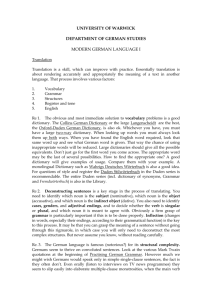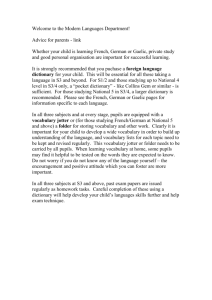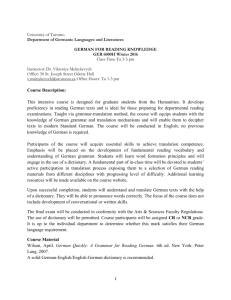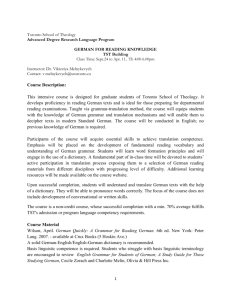UNIVERSITY OF WARWICK DEPARTMENT OF GERMAN STUDIES MODERN GERMAN LANGUAGE I
advertisement
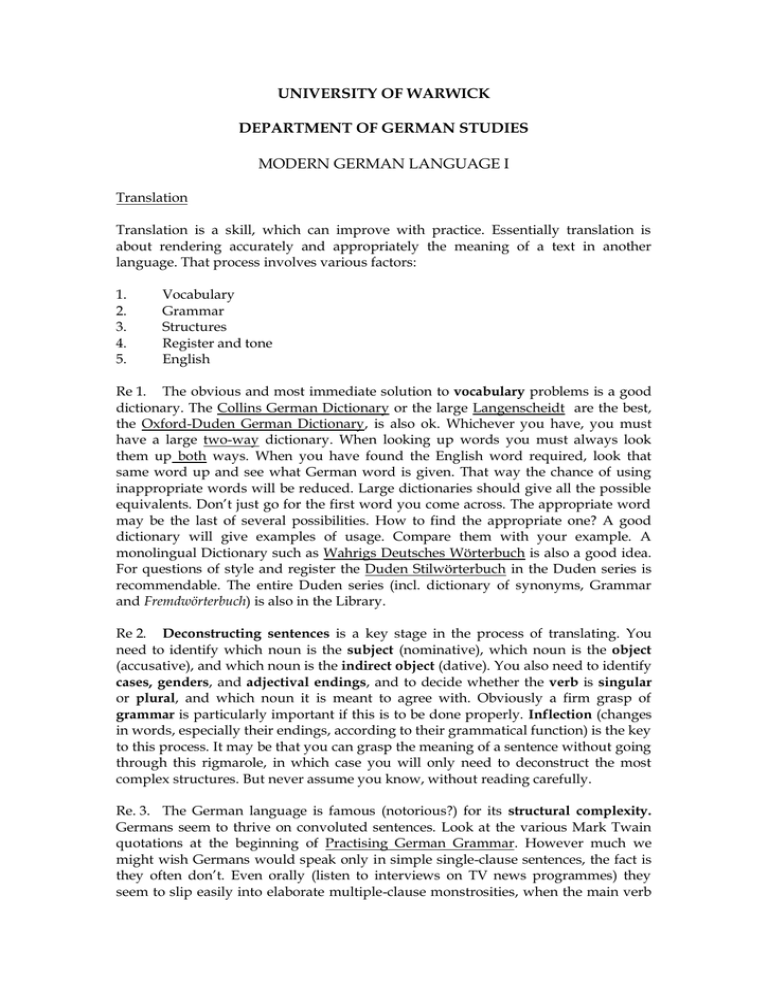
UNIVERSITY OF WARWICK DEPARTMENT OF GERMAN STUDIES MODERN GERMAN LANGUAGE I Translation Translation is a skill, which can improve with practice. Essentially translation is about rendering accurately and appropriately the meaning of a text in another language. That process involves various factors: 1. 2. 3. 4. 5. Vocabulary Grammar Structures Register and tone English Re 1. The obvious and most immediate solution to vocabulary problems is a good dictionary. The Collins German Dictionary or the large Langenscheidt are the best, the Oxford-Duden German Dictionary, is also ok. Whichever you have, you must have a large two-way dictionary. When looking up words you must always look them up both ways. When you have found the English word required, look that same word up and see what German word is given. That way the chance of using inappropriate words will be reduced. Large dictionaries should give all the possible eq u iv alen ts. D on ’t ju st g o for th e first w ord y ou com e across. T h e ap p rop riate w ord may be the last of several possibilities. How to find the appropriate one? A good dictionary will give examples of usage. Compare them with your example. A monolingual Dictionary such as Wahrigs Deutsches Wörterbuch is also a good idea. For questions of style and register the Duden Stilwörterbuch in the Duden series is recommendable. The entire Duden series (incl. dictionary of synonyms, Grammar and Fremdwörterbuch) is also in the Library. Re 2. Deconstructing sentences is a key stage in the process of translating. You need to identify which noun is the subject (nominative), which noun is the object (accusative), and which noun is the indirect object (dative). You also need to identify cases, genders, and adjectival endings, and to decide whether the verb is singular or plural, and which noun it is meant to agree with. Obviously a firm grasp of grammar is particularly important if this is to be done properly. Inflection (changes in words, especially their endings, according to their grammatical function) is the key to this process. It may be that you can grasp the meaning of a sentence without going through this rigmarole, in which case you will only need to deconstruct the most complex structures. But never assume you know, without reading carefully. Re. 3. The German language is famous (notorious?) for its structural complexity. Germans seem to thrive on convoluted sentences. Look at the various Mark Twain quotations at the beginning of Practising German Grammar. However much we might wish Germans would speak only in simple single-clause sentences, the fact is th ey often d on ’t. E v en orally (listen to in terv iew s on T V n ew s p rog ram m es) th ey seem to slip easily into elaborate multiple-clause monstrosities, when the main verb takes an eternity to appear. So we need strategies to deal with this. The most useful is to strip down a complex sentence to its bare necessities. This involves highlighting the core of the sentence by isolating all subordinate clauses, encapsulated adjectival clauses, adjectives, adverbs, etc. You can d o th is by in sertin g brack ets. It’s a corn y image, but a convoluted sentence can be likened to a coat and hat stand: one central pole with a number of hooks on the side and the top to hangs things on. Highlighting (literally) is a good idea. Using different colour highlighters often helps clarify the structure and bring out the meaning. Re. 4 Register and tone. A washing machine manual uses a different kind of language from that used by a writer to describe the rural view from your penthouse suite in leafy Leamington Spa. When reading a passage of German try to establish a) what kind of language is being used (is it technical/specialist (Fachsprache), bureaucratic, journalese, slang, dialect, colloquial, academic?) and b) the overall tone of the passage. Is it emotive or dispassionate, ironic, indignant, bitter, understated, full of hyperbole? A really good translation will provide the appropriate English tone and register. Re. 5. It’s easy to forg et th at tran slation is abou t im p rov in g on e’s com m an d of English as well as German. To find out whether your translation reads like English or translationese, see if you can persuade a literate non Germanist flat-mate (or your partner?*) to read your pristine prose and tell you if it reads well and makes sense. Try to read decent English regularly, if not a novel then at least a quality broadsheet newspaper. Editorials are usually models of clarity and precision. * Is this the ultimate test of a relationship? The seven (!) stages of translation: 1. 2. 3. 4. 5. 6. 7. Read the passage through for a general sense of the tone and register check vocabulary deconstruct the individual sentences produce a rough draft, concentrating on accuracy put the original to one side and re-write the rough draft in decent English inflict the re-write on a friend thank him/her profusely, grit teeth, and write final version It goes without saying that word processors were invented for translators. You can write and re-write ad infinitum (or should that be nauseam?). So get computer-literate if y ou ’re n ot already. Helmut Schmitz, Sept 2005, Room H210 h.schmitz@warwick.ac.uk
